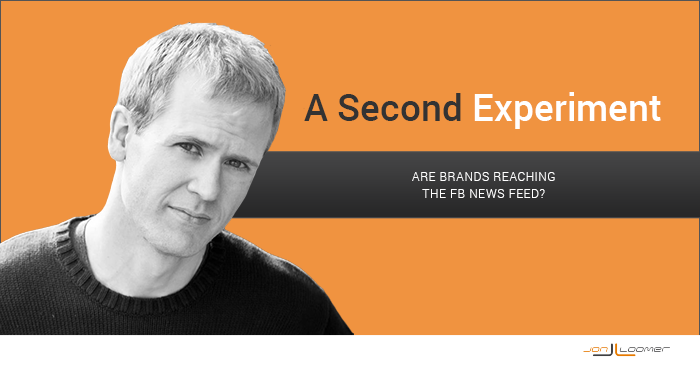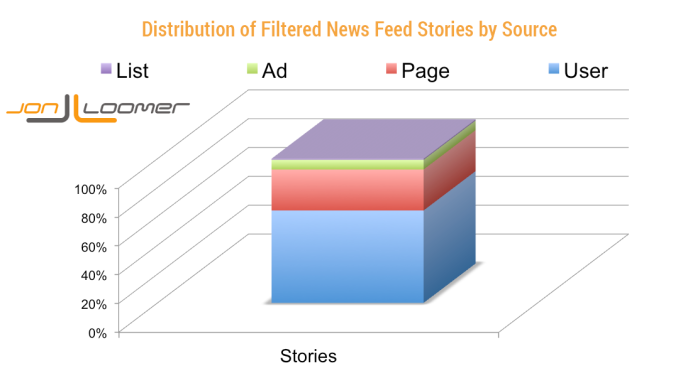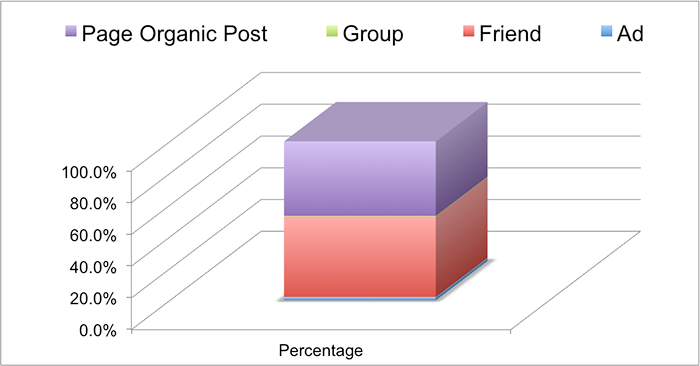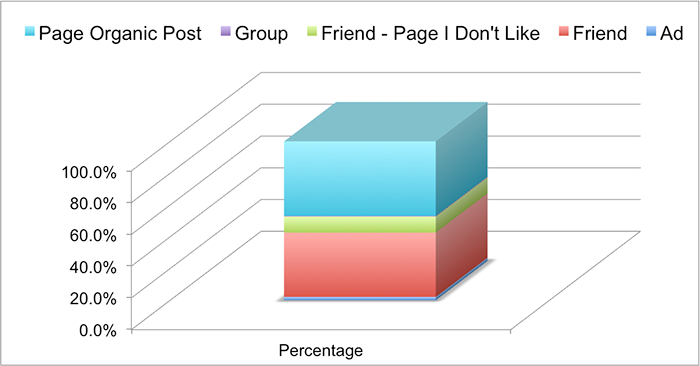
[AUDIO VERSION: As an experiment, I also recorded an audio version of this blog post. Click below to listen. Let me know if this is something you find helpful!]
Back in December, many (but not all) brands began seeing a drop in Organic ReachReach measures the number of Accounts Center Accounts (formerly users) that saw your ads at least once. You can have one account reached with multiple impressions. More. The immediate reaction was that Facebook was squeezing brands to force them to pay for advertising.
To test this theory, I ran an experiment of my own News Feed covering a 24 hour period. What I found then was that 28.4% of the content I saw in my News Feed came from 38 different brands who didn’t pay a penny to reach me.
More than three months have passed since then. Have things changed? Is the composition of my News Feed any different?
What I found was quite surprising. The composition of my News Feed has indeed changed, but not the way you’d expect.
The Experiment
The methods of my experiment three months ago and today were nearly identical. I did the following…
- Sorted my News Feed by “Most Recent”
- Documented the source of every story in my News Feed covering a 24-hour period
- If a post came from a friend, I marked it as “Friend”
- If a post came (organically) from a brand, I marked it as “Page” and noted the name of the page
- If a post was an ad, I marked it as “Ad”
I decided to dig a little bit deeper this time, however, and I also noted any time a brand was given free advertising by my friends via commenting, liking, sharing and checking in. I marked these posts as “Friends – Page I Don’t Like.”
Results: The First Experiment

First, let’s recap what I found three months ago…
- 373 Total Stories
- 239 Stories from Friends (64.1%)
- 106 Organic Stories from Pages (28.4%)
- 25 Ads (6.7%)
- 3 Stories from Lists (0.8%)
Keep in mind that for some time now, Facebook has shown — on average — about 300 of a possible 1,500 or so stories to the typical user on an average day. I was seeing a bit more than that.
Of the 106 organic page posts I saw, several brands reached me multiple times. In fact, there were three brands that reached me 10 times or more during that 24-hour period.
I concluded that my News Feed did not reflect what was being reported. If brands were getting squeezed — if they were forced to pay to reach me — I’d expect to see fewer organic page posts. But I feel 28.4% is a very healthy percentage.
And if brands could only reach me by paying, I expected to see more ads. But 6.7% seemed to be a reasonable percentage.
Results: The Second Experiment

Three months later, did anything change? You bet it did…
- 484 Total Stories
- 245 Total Stories from Friends (50.6%)
- 227 Organic Stories from Pages (46.9%)
- 10 Ads (2.1%)
- 2 Stories from Groups (0.4%)
Three months ago, I noted that I was seeing 24.3% more stories in my News Feed than the typical user (Facebook said to expect around 300). Now, I’m seeing 61.3% more than the typical user and 29.8% more than I saw three months ago.
But of course, that’s not the big news here. The biggest news is the quantity of organic page posts I am seeing. Nearly half (46.9%) of my News Feed is composed of organic posts from brands. And those 227 posts came from 74 different pages.
Reminder: I saw 106 organic posts from 38 different pages three months ago.
I rarely like pages. I can promise you that the number of pages I like now is virtually unchanged from three months ago. The 374 pages I like represent an accumulation over my seven years on Facebook.
Now, something I didn’t measure three months ago was how my friends were also helping share brand messages. The addition of this data makes the prevalence of organic brand-related content all-the-more startling.
Of the 245 stories I saw from friends, 49 (20%) promoted a brand in some way by checking in (17), sharing a page photo (10), liking a page (8), sharing a page link (6), commenting on a page post (4) or liking a page post (4). Let me reiterate: None of these were ads.
So we could take this a step further. Of the 484 total stories I saw, 276 (57.0%) were organic posts that promoted brands in some way. These are startling numbers.

Oh, and you know how the common refrain right now is that brands can only reach you by paying for ads, right? Well, only 2.1% of my News Feed stories (down from 6.7% three months ago) were ads.
A Few Notes on Weaknesses
First, the obvious: This is an extremely small sample size. I am only one user. What I see does not reflect what you see.
Second, I can’t be sure about how much I’m not seeing. However, I do have evidence that I see a very high percentage of page content. As mentioned earlier, I only like 374 pages in all, and many of these are now inactive. I did a quick check of all movies I like, and the only one that posted during the past 24 hours showed up in my News Feed.
To suggest that 20% of the pages I’ve liked over several years were active during a single 24-hour period is actually quite reasonable.
Third, maybe I like a lot of pages that are favored by Facebook. The brands who showed up most frequently were big brands who posted a lot like Bleacher Report (19), The Onion (19), Mashable (16) and Tech Crunch (12). These brands certainly weren’t being kept from my News Feed, but they are also considered “news” pages that may get some favoritism.
However, that doesn’t explain why I also saw stories from much smaller brands like these (number of likes in parentheses):
- Alyssa Griffeth Real Estate (72)
- golfcolorado9holes.com (89)
- Osgood Team – Rocky Mountain Real Estate Advisors (213)
- BeManaged (250)
- Moody Eyes (303)
- Ad Club Denver (831)
- Rely Local Douglas County (1,112)
- Brew Crew Ball (1,362)
- Christopher S. Penn (1,372)
- Naked Specs (1,416)
- Powers Collectibles LLC (1,614)
- Webonize: Online Marketing for Small Business (1,837)
- Parker Colorado Community Blog (2,365)
- My Kids’ Adventures (2,542)
- Roto Arcade (4,077)
- Mike Gingerich .com (4,271)
- Carla Neggers (6,953)
- Share 4 Kids Foundation (8,551)
- The Nonprofit Facebook Guy (9,762)
- AdEspresso (11,411)
- Grandma Mary (11,692)
- Beth Kanter (14,693)
- Inbound Zombie (17,001)
- Econsultancy (24,498)
That’s 24 pages that I had eyeballed as ones that would have smaller audiences. There could have been more.
Finally, results are fluid. Maybe something crazy happened during the 24-hour period I analyzed. Maybe there was a bug in filtering. Maybe brands posted far more frequently than they do typically, which slanted my results.
Maybe.
What Does It All Mean?
Now, I’m not going to make any grand proclamations about how my own results are proof that something definitely is or isn’t happening. But I have a theory regarding why I see what I see.
I won’t argue whether Organic Reach is down. That’s not debatable for most pages. What could be up for debate is the accuracy of that data since we repeatedly see bugs and inconsistencies with Reach data.
However, I know that many brands have seen a drop in measurable actions as well. While I’m not convinced Reach means much of anything, a drop in actions is certainly convincing that something is going on.
And yet, I’m seeing a TON of organic content from brands. Why?
Facebook can’t harm user experience and be successful. So it’s in their best interests to allow users to see the brand content they want to see. And Facebook knows which content that is through user actions.
So I believe that we’re still seeing just as many brand posts as we’ve always seen. Maybe even more, if you take my latest results seriously. For this to happen while so many brands have seen a drop in Reach, however, Facebook needs to be concentrating my News Feed with content I engage with most.
That doesn’t mean that the system is perfect. Some good brands may be getting harmed in the process. But some brands are seeing no change in — or even improved — Reach since December. And based on my latest experiment, this is not surprising.
That’s a theory. It’s still difficult to explain the doubling of organic brand content I saw in this latest experiment, but we can also go back to the “small sample size” explanation in that case.
Bottom line is that the results are interesting. They don’t reflect the overwhelming sentiment from brands that we’re approaching the Organic Reach Apocalypse.
Lesson: Post Frequently
This is the one lesson that appears clear from my results: If you want to reach more people, post frequently.
Of the 74 big and small brands who reached my News Feed during a 24-hour period, 41 posted multiple times. In fact, 29 posted three times or more.
I’ve said it repeatedly, but I’ll say it again: Stop obsessing over the reach of a single post. Reach more people by posting multiple times per day. Measure your reach over a given day or week rather than on a post-by-post basis.
Understand that even though 74 brands reached me, I wasn’t on Facebook for 24 hours. I only saw those posts because I ran this experiment. I didn’t notice the vast majority of those posts.
That’s not Facebook’s fault. That’s understanding that users aren’t on Facebook 24 hours per day. Post throughout the day to give yourself more chances to reach your audienceThis is the group of people who can potentially see your ads. You help influence this by adjusting age, gender, location, detailed targeting (interests and behaviors), custom audiences, and more. More!
Your Turn
I encourage you to run a similar experiment. What are you seeing? And how do you explain the results?
Let me know in the comments below!






